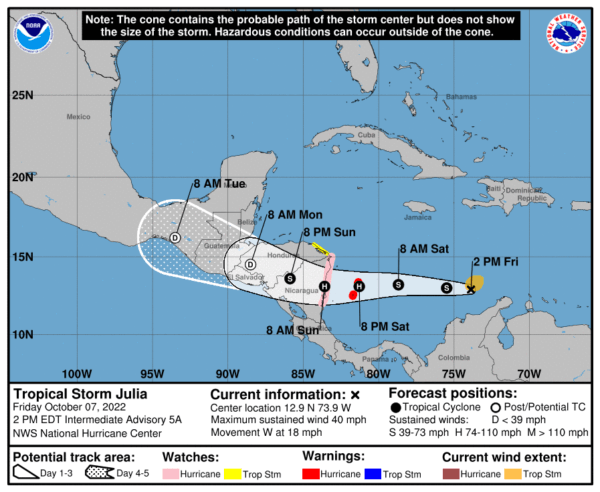Central America on Alert as Tropical Storm Julia Strengthens

Nicaragua is in the trajectory of Tropical Storm Julia and begins preparations for potential heavy rains.
HAVANA TIMES – Central America, one of the areas of the world most vulnerable to the climate crisis, is on alert and has activated its relief teams in the face of forecasts of heavy rains from the recently formed Tropical Storm Julia is moving west in the Caribbean, authorities reported on Thursday.
Currently north of eastern Colombia the weather system is gaining in organization as it moved through the western Lesser Antilles and is expected to cause heavy rains that will affect northern South America through Friday.
The US National Hurricane Center reported that the system became a tropical storm on Friday with 40 mph (65 kph) maximum sustained winds. The center of TS Julia is moving quickly west at 18 mph (29 kph) and is expected reach hurricane intensity by Saturday night as it approaches the east coast of Nicaragua.
In Nicaragua, the Armed Forces announced Thursday the suspension for three days of boat sailings in the Caribbean Sea starting Friday, and the Government affirmed that the authorities are preparing for the impact of the phenomenon on Sunday.
In Honduras, The Center for Atmospheric, Oceanographic and Seismic Studies forecasts the storm will be entering the country on Monday around noon, and that it will drop “amounts of rain of up to 200 millimeters” (7.8 inches), so the “risk of river overflows and flooding in the lower lands is high as well as that of landslides in the mountains.”
This is how they prepare
The president of Guatemala, Alejandro Giammattei, said through his social networks that he gave instructions so that “the institutions are ready to attend and support” the residents of the Central American country “in the face of the alert of a new tropical cyclone.”
In Panama, the authorities said Julia has had a trajectory very close” to the country, “influencing the intensity and duration of the rains with amounts of between 100 and 200 millimeters accumulated per day along the Pacific and some regions of the Panamanian Caribbean”.
Panama is in the thick of its long rainy season, which runs from May to October. The precipitations typical of the season and others associated with the tails of hurricanes and storms have caused flooding, landslides, and several deaths in recent weeks, especially in the west of the country.
In Costa Rica, the National Emergency Commission has activated the local emergency committees for possible evacuations in its northern zone, bordering Nicaragua, and the southern zone, bordering Panama.
According to the National Meteorological Institute of Costa Rica, the indirect effects of TS Julia in the country will begin on Saturday and could last until Tuesday with heavy rains.
Annually in Central America, the rains caused by hurricanes and storms, or associated with these, are increasingly frequent and more violent, leaving hundreds of deaths and devastating losses of crops and infrastructure, in a region already marked by poverty.





